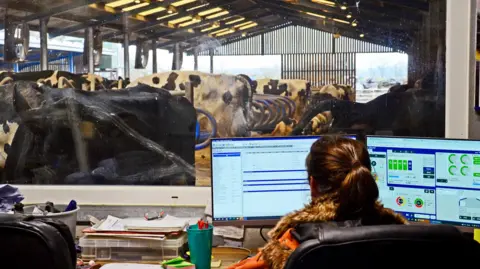It’s a sleepy August morning when I meet husband-and-wife design duo Mafalda Muñoz and Gonzalo Machado at their gallery Machado-Muñoz in Madrid’s Justicia, the fashionable barrio with a similar feel to Manhattan’s West Village.
Muñoz and Machado met as teenagers in Madrid. Together for 16 years, they have been married for 11 and are parents to two children. They share a passion for design that was nurtured throughout their childhoods: Muñoz’s late father Paco established his design firm Casa & Jardin in 1951 (at its zenith it utilised the skills of more than 300 artisans) and eight years later founded the furniture company Darro. Many consider him to be the founder of modern Spanish design.


The gallery opened in May with a soft-launch party: it’s what Muñoz calls “an evolution” of the gallery of the same name the pair launched 10 years ago with a focus on contemporary design. The couple have a close, almost symbiotic connection, and there’s also a lot of laughter. “We are together on everything,” says Muñoz. “My parents used to work together too, so it was kind of natural.” The original gallery was about to move to a new city space when the Covid-19 pandemic struck and it was forced to close. But this did not stall the couple’s creative output, and their interior-design business Casa Muñoz has continued to thrive. Among its projects are the apartment of Spanish model Eugenia Silva, an Ibiza townhouse, the restaurant at the Fondation Beyeler art museum in Switzerland and the Casa Taberna hotel and restaurant in Pedraza, Spain, which is run by Muñoz’s half-sister, Samantha Vallejo-Nágera.


Reopening the gallery after a five-year hiatus has allowed the pair to reflect on their singular perspective. “We feel more mature now,” says Muñoz. Machado adds: “At the time, we were fascinated with the contemporary design world. We wanted to give a voice to Spanish design. Now we want to be without restriction.” The curation at their space spans 20th-century classical design, antiquities, art and objets. “We feel that this is the kind of gallery we would like to visit. A place where you can be amused by an artefact, an artwork or a piece of furniture,” says Machado. “It’s more about our point of view on the arts.”
That viewpoint has garnered an illustrious following. “Gonzalo and Mafalda have an extraordinary sense of taste and definitive style, whether related to their work, their home or how they entertain guests,” says Marta Ortega Pérez, the non-executive chair of Inditex, Zara’s parent company, who is a friend of the couple. “I never fail to be blown away by their exquisite personal touch and encyclopedic knowledge of art, furniture and all aspects related to interiors, as well as their individualistic flair.”

This flair is evident as we walk through the gallery, a peaceful, inspiring but very comfortable space. We sink into woven cord Audoux Minet armchairs to appreciate the Machado- and Muñoz-designed furniture, placed beside both originals and re-editions by Paco Muñoz. Beside us is a vintage Danish cabinet displaying handblown glass orbs and a simple lamp, which catches my eye. Muñoz explains its provenance: “It’s a very important lamp by Paul Dupré-Lafon that was designed for Hermès. It’s one of the few with the original parchment lampshade.” The couple see the gallery as a platform to source furnishings for their interiors projects. Muñoz continues: “We can buy things for the gallery that we can later use.”
The front half of the gallery is dedicated to rotating exhibitions. Currently displayed is the hand-carved work of Moisès Villèlia, the late Catalan sculptor known for experimenting with bamboo, and lighting by London-based designer Michael Anastassiades. His limited-edition piece from the Cheerfully Optimistic About the Future exhibition at the ICA in Milan works harmoniously with Villèlia’s mobile sculptures. “It’s different uses of the same material and we felt they work together incredibly well,” Muñoz explains.


Anastassiades refers to the pair as “passionate, absolute perfectionists”. Recalling his first meeting with them in 2015 when he was invited to participate in their inaugural exhibition, he says: “I knew from the start that what they intended to deliver was going to be of exceptional standard. We have continued to work together ever since.”
As we continue our tour, Muñoz pauses at a re-edition of her father’s stainless-steel shelves. Paco Muñoz’s legacy, an archive of more than 20,000 designs, is a frequent source of inspiration. They also have plans to relaunch the brand Darro in its entirety in the near future. Several of the craftspeople who made her father’s furniture now make the couple’s bespoke furniture. “The upholsterer we currently work with made my cradle,” Muñoz says.

With the studio and gallery, the pair’s output is prolific: they juggle 10 or so interior projects at any one time. Their time is split between two offices, one in Madrid and the other in Gstaad, Switzerland. And they keep expanding their interests. They are currently working with Belgian lighting brand Authentage on a line of architectural lights. “And we want to do faucets next,” says Machado, hinting they also have interior work in the pipeline from Madison Avenue to Madrid.
The duo, however, bring their own talents to each project. Muñoz is a skilled interior architect, while Machado, who also studied interior design, is a successful photographer who honed his skills as an assistant for Mario Testino before establishing a career shooting editorial for magazines. He acts as the studio’s creative visualiser. “Gonzalo has special vision,” says Muñoz. “It’s super-intuitive and very impressive.”
“I’m always framing. It’s a disease,” laughs Machado, who enjoys work assignments but finds photographing his own work “torture”. His perfectionism means he sometimes refuses to release the images. Thankfully, Muñoz is more than understanding: “We think precision is one of the most important things when you create.”















































































































































You must be logged in to post a comment Login